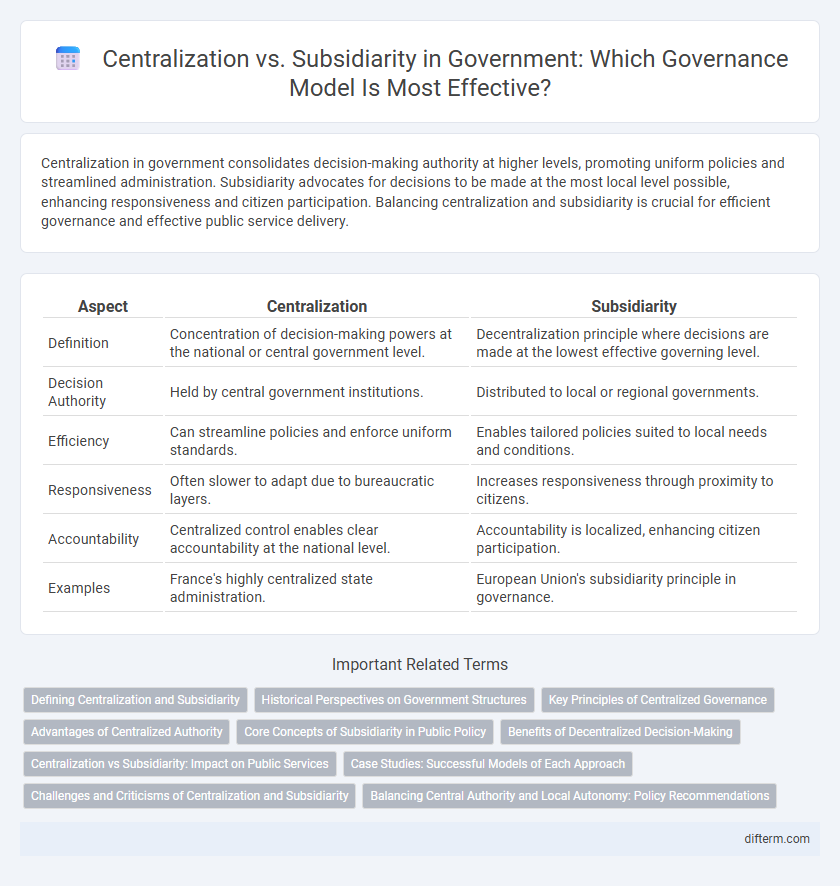Centralization in government consolidates decision-making authority at higher levels, promoting uniform policies and streamlined administration. Subsidiarity advocates for decisions to be made at the most local level possible, enhancing responsiveness and citizen participation. Balancing centralization and subsidiarity is crucial for efficient governance and effective public service delivery.
Table of Comparison
| Aspect | Centralization | Subsidiarity |
|---|---|---|
| Definition | Concentration of decision-making powers at the national or central government level. | Decentralization principle where decisions are made at the lowest effective governing level. |
| Decision Authority | Held by central government institutions. | Distributed to local or regional governments. |
| Efficiency | Can streamline policies and enforce uniform standards. | Enables tailored policies suited to local needs and conditions. |
| Responsiveness | Often slower to adapt due to bureaucratic layers. | Increases responsiveness through proximity to citizens. |
| Accountability | Centralized control enables clear accountability at the national level. | Accountability is localized, enhancing citizen participation. |
| Examples | France's highly centralized state administration. | European Union's subsidiarity principle in governance. |
Defining Centralization and Subsidiarity
Centralization refers to the consolidation of decision-making authority and administrative powers within a central government or authority, ensuring uniform policies and streamlined governance. Subsidiarity emphasizes delegating decision-making to the lowest or most localized level capable of addressing issues effectively, promoting autonomy and responsiveness in governance. The principle of subsidiarity seeks to balance efficiency with local empowerment, contrasting with centralization's focus on hierarchical control.
Historical Perspectives on Government Structures
Historical perspectives on government structures reveal a persistent tension between centralization and subsidiarity, where centralized states often emerged to consolidate power, streamline administration, and enhance national security. Subsidiarity principles, rooted in political philosophy and practiced in medieval federalism and local governance, emphasize delegating authority to the most immediate or local level capable of addressing issues effectively. This balance between central control and local autonomy has shaped the evolution of constitutional frameworks from feudal systems to modern federal states worldwide.
Key Principles of Centralized Governance
Centralized governance prioritizes uniform policy implementation and streamlined decision-making processes to ensure coherence across all administrative levels. It centralizes authority within a singular governing body, enhancing resource allocation efficiency and reducing regulatory fragmentation. Key principles include strong hierarchical structures, centralized control over public services, and consolidated fiscal management to maintain national unity and policy consistency.
Advantages of Centralized Authority
Centralized authority enhances policy consistency by enabling uniform decision-making across all government levels, reducing regional disparities. It facilitates efficient resource allocation and rapid implementation of national strategies during emergencies. Centralized control also strengthens accountability by consolidating responsibility within a singular governing body.
Core Concepts of Subsidiarity in Public Policy
Subsidiarity in public policy emphasizes decision-making at the most immediate or local level capable of addressing issues effectively, ensuring that higher authorities intervene only when necessary. It fosters efficiency, accountability, and responsiveness by empowering local governments and communities to manage their own affairs while central authorities provide support for broader challenges. This principle balances power distribution, promotes democratic participation, and reduces administrative burdens through decentralized governance structures.
Benefits of Decentralized Decision-Making
Decentralized decision-making empowers local governments to tailor policies to community-specific needs, enhancing responsiveness and efficiency. It promotes greater citizen participation and accountability by bringing governance closer to the people. This approach fosters innovation by allowing diverse regions to experiment with solutions suited to their unique economic and social contexts.
Centralization vs Subsidiarity: Impact on Public Services
Centralization concentrates decision-making authority at higher government levels, which can streamline public service delivery and ensure uniform standards across regions. Subsidiarity delegates authority to local governments, allowing for tailored public services that better address local needs and promote community engagement. Balancing centralization and subsidiarity influences the efficiency, responsiveness, and equity of public services in sectors such as healthcare, education, and infrastructure.
Case Studies: Successful Models of Each Approach
The Scandinavian welfare states exemplify successful centralization through their robust national healthcare and education systems, ensuring uniform service delivery and equity across regions. In contrast, Switzerland's subsidiarity model empowers cantons with significant autonomy, fostering tailored policies that reflect local preferences and enhance democratic participation. Comparative analyses reveal that centralization promotes standardization and efficiency, while subsidiarity supports flexibility and local innovation in governance.
Challenges and Criticisms of Centralization and Subsidiarity
Centralization often faces criticism for reducing local autonomy and creating bureaucratic inefficiencies that hinder responsive governance. Subsidiarity can encounter challenges related to inconsistent policy implementation and coordination difficulties among various government levels. Both approaches struggle with balancing power distribution while ensuring effective public service delivery and accountability.
Balancing Central Authority and Local Autonomy: Policy Recommendations
Balancing central authority and local autonomy requires policies that clearly delineate decision-making responsibilities while promoting collaboration between government tiers. Implementing frameworks that allow local governments to address community-specific needs enhances service delivery and democratic participation. Establishing intergovernmental councils and fiscal arrangements can optimize resource allocation and reduce overlaps, fostering effective governance.
centralization vs subsidiarity Infographic

 difterm.com
difterm.com